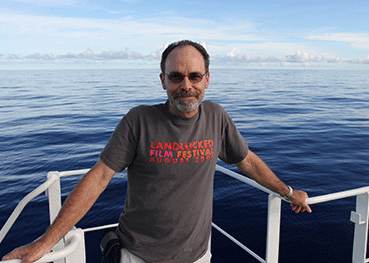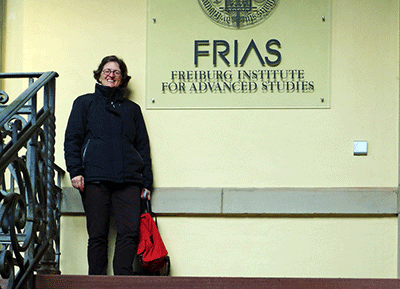UI Faculty Use Professional Development Awards to Discover, Create, Publish, Teach


If you’re a tenured or tenure-track faculty member at the University of Iowa, chances are you’ve got at least two classes to teach each semester, a research lab to supervise, several graduate students to mentor, university and departmental committees to serve on, and a handful of articles to review for a journal in your field—not to mention your own research or creative work to perform. Between teaching, mentoring, and service, how do UI faculty find the time to, say, chair geological expeditions to the Mariana Trench or interview Holocaust orphans scattered around the world?
Professional development awards (PDAs)—informally called research assignments, research-intensive leaves, and sabbaticals—allow tenured and tenure-track UI faculty a semester free from teaching to perform research, write books and articles, create art, improve courses, attend conferences in their fields, and exchange ideas with colleagues. The benefits of a professional development award extend much further than faculty members’ careers, as active, prolific scholars and artists tend to teach stronger, more relevant courses, attract and graduate better students who are more competitive on the job market, and bring funding and prestige to their college and the University.
Faculty qualify for PDAs only after they’ve taught at the UI for ten consecutive semesters. Applicants must then submit to their departmental chairs and a collegiate committee a lengthy description of their proposed project, explaining why it’s important to their discipline, the UI, and the state of Iowa; how they’ve prepared for it; and their plans to disseminate its results and use the work in their teaching. During the review process, the departmental chair makes sure that the applicant’s classes can be covered by other faculty during the PDA semester. If the application is approved and a PDA awarded, the faculty member is released from a semester of teaching with the understanding that, in return for regular pay and benefits, he or she will continue to perform University service (e.g., advising graduate students, serving on thesis committees) while on research leave.
After they complete a PDA, faculty members must submit a sequence of reports detailing their progress, which become part of their permanent records. Each PDA is generally expected to result in one or more publications, exhibits, professional performances, or new courses.
 Historian Elizabeth Heineman in her UI office, surrounded by research materials on the WWII-era Kindertransport program
Historian Elizabeth Heineman in her UI office, surrounded by research materials on the WWII-era Kindertransport program
Some faculty spend their PDAs working in labs or offices on the UI campus, while others travel to distant cities, states, or countries to conduct fieldwork; collaborate with experts from around the world; and visit specialized libraries, archives, and institutes.
Elizabeth Heineman, professor in the departments of History and Gender, Women’s and Sexuality Studies, spent her 2012–13 research assignment at the Freiburg Institute for Advanced Studies in Germany, where she researched Kindertransport, the 1938 British-led rescue effort that placed 10,000 Jewish children from Germany, Austria, Czechoslovakia, and Poland into British foster care. “I’m looking at family histories,” she says, “at the ways that family dynamics influenced the way families responded to danger. After World War II, how did families process and recover, and how did family stories get intertwined with the larger stories of persecution and genocide?”
During her PDA semester, she visited a dozen archives in Europe and the Middle East, interviewed people who were rescued via Kindertransport as children, and began writing a book tentatively titled Kindertransport: A Family History. Though focused on World-War-II–era Europe, Heineman’s research has direct applications to Iowa, which has seen an influx of East African refugees in recent years—many of them unaccompanied Somalian and Sudanese children. Her research will help Iowans to understand the challenges faced by child refugees as well as their host societies.
 Geologist Mark Reagan pauses for a photo on a geologic research vessel
Geologist Mark Reagan pauses for a photo on a geologic research vessel
Mark Reagan, professor and chair of the Department of Earth and Environmental Sciences, will also be conducting research abroad during his PDA. This July, he’ll board the research ship Joide’s Resolution (see photo above) as co-chief scientist for the International Ocean Discovery Program’s expedition to drill through a sequence of lavas beneath the Pacific Ocean. He and twenty-eight scientists from around the world will drill over 3,000 feet into the ocean floor 600 miles south of Japan and analyze the resulting rock samples to find out why the Pacific Plate—the 60-mile-thick slab of rock beneath the ocean—began to sink, or “subduct,” beneath a neighboring plate 52 million years ago, creating the Mariana Trench.
“Plate tectonics is the driving force of everything that goes on geologically on earth,” he says. “Earthquakes, volcanoes, the creation of mountains—it’s all related to the motions of the plates. Subduction is the driving force behind plate tectonics, but how it starts is one of its most poorly understood aspects.” By discovering how and why subduction begins and evolves, Reagan and his colleagues will help other scientists better understand the origin of subduction-related earthquakes, volcanoes, and deep sea ecosystems.
When they’ve completed their fieldwork, both Heineman and Reagan will return to Iowa and spend months in front of their computers analyzing their data and writing up the results, publication remaining the chief way that research in most academic fields is shared and assessed. Reagan, who has at least five papers he’d like to write about data he already has in hand, looks forward to being able to concentrate on research and writing: “During the semester, we’re teaching, we’re directing students, we’re doing service work for the university, and we’re doing as much research as we can. A PDA allows faculty to really focus on research, think through a data set, and publish.”
Heineman agrees. “Writing a book of a few hundred pages isn’t something you can squeeze into the evenings after a full day of teaching and committee work. You need some dedicated time to do the research and write up the results.”
With all this talk about knowledge creation, it might seem that UI PDAs chiefly benefit the global research community—but in fact, the most immediate beneficiaries are UI students, who have the opportunity to learn from scholars and artists at the tops of their fields.
“We all bring our research back to our teaching,” notes Heineman. “Our students are getting better lectures, better classroom exercises, and a better learning experience than they would if they were being taught by teachers, who, with all good intentions, could only draw on textbooks.” Ultimately, this affords students a better position when they’re applying for jobs and graduate programs.
Many faculty spend a significant part of their PDAs refreshing their course materials, incorporating fieldwork experiences and artifacts. Heineman, who teaches courses on gender, human rights, Germany, and Europe, has developed several new courses as a result of her research assignments, and Reagan, who teaches an undergraduate course in mineralogy, plans to design research projects for students using his Pacific Plate rock samples. “When I get back,” he says, “I’ll have a ton of samples—maybe even literally. We’ll be trying to answer all sorts of questions about them.” Undergraduates he supervises regularly perform analyses and conduct their own research. One recent student presented her study of ocean-floor rocks at a major international conference.
 Heineman at the Freiberg Institute for Advanced Studies in Germany
Heineman at the Freiberg Institute for Advanced Studies in Germany
PDAs also give faculty time to prepare and submit external grant applications—grants they often end up winning, thanks to the research and creative work the PDAs allowed them to complete. According to the UI’s Office of the Executive Vice President and Provost, $4.86 million in grants have come to the University as a direct result of work done during 2012–13 research assignments, with more continuing to come in as grants are awarded. These grants fund everything from student research assistants and research labs (which employ and train hundreds of students across campus) to art installations and outreach programs. Plus, they bring acclaim to the university, attracting and retaining first-rate students, faculty, and staff.
Professional development awards are, in short, essential to the University of Iowa’s and the College of Liberal Arts and Sciences’ research and teaching missions. Far from employment perks or rewards for longevity, they’re necessary tools that allow faculty to do their jobs. As Heineman puts it, “We’re hired to be teachers and researchers. There are all kinds of ways that the UI helps us in our teaching mission; PDAs are how it helps us in our research mission.” And Reagan: “My job as a researcher is to help to create knowledge so that we can better understand the way the universe works, and I can’t do that well without time set aside for concentrated research and writing.” Given the millions of dollars in grant funding that result from PDAs; the innovative new courses and programs; the countless discoveries, inventions, publications, and works of art; and the enhanced research profile of the University, one can hardly imagine a wiser investment.
Other recent PDAs in the College of Liberal Arts and Sciences:
Juan Pablo Hourcade (Computer Science) researched, wrote, and published Designing Technologies for Children, an open-source online book that helps educators, child psychologists, communication scholars, graphic designers, and computer scientists understand how the brain, body, and environment interact when children use technology.
Bob McMurray (Psychology) collaborated with an educational company in Iowa City to write a Small Business Innovation grant to develop a new assessment for struggling readers, and he’s currently conducting research at reading disorder labs at Oxford University in England.
Michaela Hoenicke-Moore (History) began writing a book on American foreign policy debates in the twentieth century; developed a new course called International Politics: The History of the Present, now an elective in the International Relations major; wrote and presented three conference papers; and completed a chapter on totalitarianism for the Oxford Handbook on the New Deal.
Chris Cheatum (Chemistry) partnered with researchers at the University of Wisconsin and the UI College of Engineering to study optical and infrared microscopy with the aim of constructing the world’s first microscope for 2-D optical and infrared imaging. The device will provide new capabilities for spectroscopic imaging of complex materials and biological tissues. Cheatum also developed new materials based on leading-edge compressive sensing methods for his undergraduate and graduate courses and co-wrote and submitted a $3 million grant application to the National Science Foundation.
—Jenna Hammerich